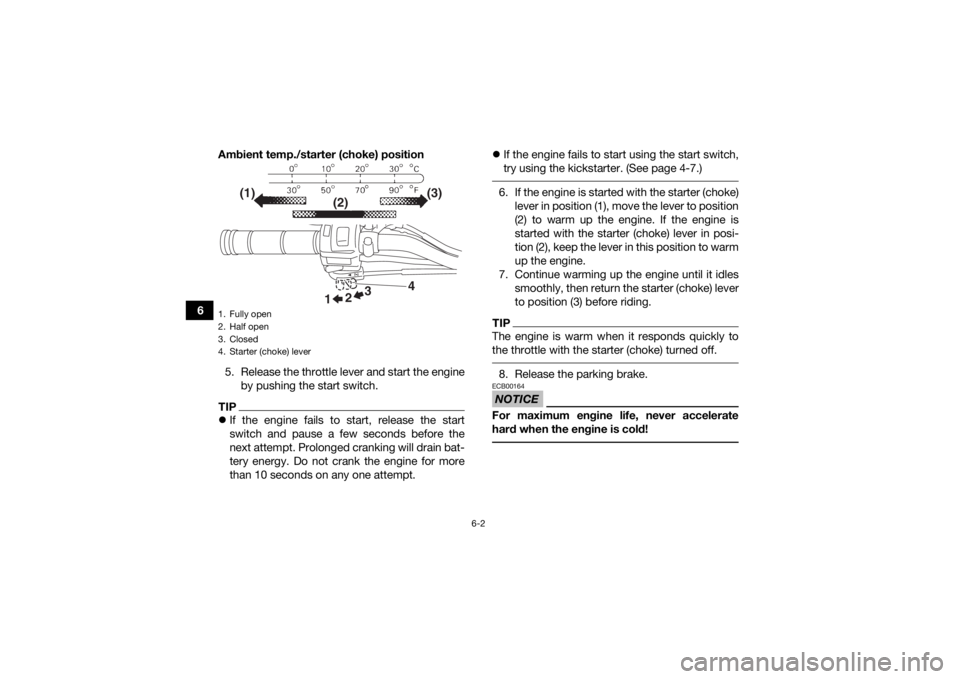Page 50 of 132
5-2
5
Throttle lever• Make sure that operation is smooth. Lubricate cable and lever
housing if necessary.
• Check lever free play, and adjust if necessary. 5-3, 8-21
Control cables • Make sure that operation is smooth. Lubricate if necessary. 8-29
Drive chain • Check chain slack, and adjust if necessary.
• Check chain condition. Lubricate if necessary. 5-3, 8-26, 8-28
Wheels and tires • Check wheel condition, and replace if damaged.
• Check tire condition and tread depth. Replace if necessary.
• Check air pressure. Correct if necessary. 5-3
Brake levers • Make sure that operation is smooth. Lubricate lever pivoting points
if necessary. 8-29
Chassis fasteners • Make sure that all nuts, bolts and screws are properly tightened. 5-6
Instruments and switches • Check operation, and correct if necessary. 5-6
ITEM ROUTINE PAGEUBW461E0.book Page 2 Tuesda
y, January 31, 2017 5:13 PM
Page 51 of 132

5-3
5
EBU19542FuelMake sure that there is sufficient fuel in the tank.
(See page 4-8.)EBU19561Engine oilMake sure that the engine oil is at the specified
level. Add oil as necessary. (See page 8-11.)EBU34490Transmission oilMake sure that the transmission oil is at the spec-
ified level. Add oil as necessary. (See page 8-14.)EBU19653Front and rear brakesBrake levers
Check for correct free play in the brake levers. If
the free play is incorrect, adjust it. (See pages
8-23 and 8-25.)
Check operation of the levers. They should
move smoothly and there should be a firm feel-
ing when the brake is applied. If not, have the
ATV checked by a Yamaha dealer. Brake operation
Test the brakes at slow speed after starting out to
make sure they are working properly. If the brakes
do not provide proper braking performance,
check the brake shoes for wear. (See page 8-22.)
EBU19762Throttle leverCheck the operation of the throttle lever. It must
open smoothly and spring back to the idle position
when released. Have a Yamaha dealer correct if
necessary.EBU19771Drive chainCheck the condition of the drive chain and check
the drive chain slack. Lubricate and adjust the
drive chain as necessary. (See page 8-26.)EBU19797TiresCheck tire pressure regularly to make sure it is at
the recommended specifications. Also check for
wear and damage.
UBW461E0.book Page 3 Tuesda
y, January 31, 2017 5:13 PM
Page 55 of 132

6-1
6
EBU19882
OPERATION
EBU19902Read the Owner’s Manual carefully before riding
the ATV. If there is a control or function you do not
understand, ask your Yamaha dealer.
WARNING
EWB00632Read the Owner’s Manual carefully to become
familiar with all controls in order to help pre-
vent any loss of control, which could cause an
accident or injury. EBU36361Starting a cold engineNOTICEECB00151See the “Engine break-in” section on page 6-3
prior to operating the engine for the first time. 1. Set the parking brake. (The engine can bestarted only when the rear brake lever is ap-
plied.)
2. Turn the fuel cock to “ON”. 3. Turn the key to “ON” and set the engine stop
switch to “ ”.
4. Position the starter (choke) lever according to the ambient temperature.
Position (1):
Cold engine start with ambient temperature
below 5 °C (40 °F).
Position (2):
Cold engine start with ambient temperature
between 0 °C (30 °F) and 30 °C (90 °F).
Position (3):
Cold engine start with ambient temperature
above 25 °C (80 °F).
UBW461E0.book Page 1 Tuesda y, January 31, 2017 5:13 PM
Page 56 of 132

6-2
6Ambient temp./starter (choke) position
5. Release the throttle lever and start the engine by pushing the start switch.
TIPIf the engine fails to start, release the start
switch and pause a few seconds before the
next attempt. Prolonged cranking will drain bat-
tery energy. Do not crank the engine for more
than 10 seconds on any one attempt.
If the engine fails to start using the start switch,
try using the kickstarter. (See page 4-7.)
6. If the engine is started with the starter (choke)
lever in position (1), move the lever to position
(2) to warm up the engine. If the engine is
started with the starter (choke) lever in posi-
tion (2), keep the lever in this position to warm
up the engine.
7. Continue warming up the engine until it idles smoothly, then return the starter (choke) lever
to position (3) before riding.TIPThe engine is warm when it responds quickly to
the throttle with the starter (choke) turned off. 8. Release the parking brake.NOTICEECB00164For maximum engine life, never accelerate
hard when the engine is cold!
1. Fully open
2. Half open
3. Closed
4. Starter (choke) lever
4
3
2
1
(1) (3)
(2)
UBW461E0.book Page 2 Tuesda y, January 31, 2017 5:13 PM
Page 57 of 132

6-3
6
EBU20292Starting a warm engineFollow the same procedure as for starting a cold
engine, with the exception that the starter (choke)
is not required when the engine is warm. Instead,
start the engine with the throttle slightly open.EBU36860Engine break-inTIPFor ATVs equipped with an odometer or an hour
meter, follow the figures given in km (mi) or the
figures given in hours.
For ATVs not equipped with an odometer or
hour meter, follow the figures given in hours. There is never a more important period in the life
of your engine than the first 240 km (150 mi) or 20
hours of riding. For this reason, you should read
the following material carefully.
Since the engine is brand new, do not put an ex-
cessive load on it for the first 240 km (150 mi) or
20 hours. The various parts in the engine wear and
polish themselves to the correct operating clear-
ances. During this period, prolonged full-throttle
operation or any condition that might result in en-
gine overheating must be avoided. 0–120 km (0–75 mi) or 0–10 hours
Avoid prolonged operation above 1/2 throttle.
Vary the speed of the ATV regularly. Do not oper-
ate it at one set throttle position.
120–240 km (75–150 mi) or 10–20 hours
Avoid prolonged operation above 3/4 throttle. Rev
the engine freely, but do not use full throttle at any
time.
240 km (150 mi) or 20 hours and beyond
The ATV can now be operated normally.
NOTICEECB00221If any engine trouble should occur during the
engine break-in period, immediately have a
Yamaha dealer check the ATV. EBU36370ParkingWhen parking the ATV, apply the rear brake lever,
stop the engine, apply the parking brake, and then
turn the fuel cock to “OFF”.
UBW461E0.book Page 3 Tuesda y, January 31, 2017 5:13 PM
Page 58 of 132
6-4
6
EBU36380Parking on a slope
WARNING
EWB04130Avoid parking on hills or other inclines. Parking
on a hill or other incline could cause the ATV to
roll out of control, increasing the chance of an
accident. If you must park on an incline, place
the ATV transversely across the incline, stop
the engine, apply the parking brake, and then
block the front and rear wheels with rocks or
other objects.Never park the ATV on hills that are too steep
to walk up easily.
1. Bring the ATV to a stop by applying the
brakes.
2. Stop the engine.
3. With the rear brake lever applied, apply the parking brake, and then slowly release the
rear brake lever.
4. Turn the fuel cock to “OFF”.
1. Parking brake lock plate
1
UBW461E0.book Page 4 Tuesda y, January 31, 2017 5:13 PM
Page 71 of 132
7-11
7
Do not ride in areas posted “no trespassing”.
Do not ride on private property without getting
permission. Select a large, flat, unpaved area to become famil-
iar with your ATV. Make sure that this area is free
of obstacles and other riders. You should practice
control of the throttle, brakes, and turning techni-
ques in this area before trying more difficult ter-
rain.
Set the parking brake and follow the instruction on
page 6-1 to start the engine. Once it has warmed
up you are ready to begin riding your ATV. Re-
member that the engine and exhaust pipe will be
hot when riding and afterwards; do not allow skin
or clothing to come in contact with these compo-
nents.
With the engine idling, release the parking brake.
Apply the throttle slowly and smoothly. You will
start to accelerate. If the throttle is applied too
UBW461E0.book Page 11 Tuesday, January 31, 2017 5:13 PM
Page 72 of 132

7-12
7abruptly, the vehicle may lurch forward or the front
wheels may lift off the ground, resulting in a loss of
directional control. Avoid higher speeds until you
are thoroughly familiar with the operation of your
ATV.
When slowing down or stopping, release the
throttle and apply the brakes smoothly and evenly.
Improper use of the brakes can cause the tires to
lose traction, reducing control and increasing the
possibility of an accident.
TURNING YOUR ATV
WARNING
EWB01772Always follow proper procedures for turning as
described in this Owner’s Manual. Practice
turning at low speeds before attempting to turn
at faster speeds. Do not turn at speeds too fast
for your skills or the conditions. ATV could go
out of control, causing a collision or overturn. To achieve maximum traction on unpaved surfac-
es, the two rear wheels turn together at the same
speed. Therefore, unless the wheel on the inside
of the turn is allowed to slip or lose some traction,
the ATV will resist turning. A special turning tech- nique must be used to allow the ATV to make
turns quickly and easily. It is essential that this skill
be learned first at low speed.
As you approach a curve, slow down and begin to
turn the handlebars in the desired direction. As
you do so, put your weight on the footboard to the
outside of the turn (opposite your desired direc-
tion) and lean your upper body into the turn. Use
the throttle to maintain an even speed through the
turn. This maneuver will let the wheel on the inside
of the turn slip slightly, allowing the ATV to make
the turn properly.UBW461E0.book Page 12 Tuesday, January 31, 2017 5:13 PM